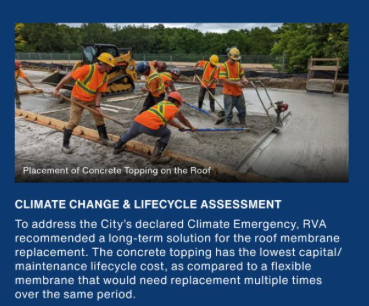Sustainable Rehabilitation of Springbank Reservoirs in London, Ontario
R.V. Anderson Associates Limited, Mark Bruder, Michael Holstenson, Madison Kooting, Emily Soscia, Reanna Lynn, Paul Mikoda, Patricia Lupton
Click on the image to view the full poster
Springbank Reservoirs 1 and 3 are located on Reservoir Hill on Commissioners Road in the City of London (the City), Ontario. Built in the late 1960’s, the reservoirs provide essential storage capacity for the City. The reservoirs are buried above grade and approximately 100 m long by 100 m wide by 7 m deep. Over the past 30 years, the City has completed various structural rehabilitation and repairs of the reservoirs.
In 2019, the City retained R.V. Anderson Associates Limited (RVA) to complete design of the roof membrane replacement and to assess the condition of the reservoirs. This was to develop suitable repair/rehabilitation details and to extend the service life of the reservoirs. Starting at conceptual design, RVA was focused on selecting sustainable solutions. This was to directly benefit the City’s residents and to actively promote low-carbon design/construction. Some of these solutions include the following:
1. Using a robust 150-mm thick concrete topping as the roof membrane replacement instead of another thin flexible geosynthetic membrane (such HDPE or EPDM). Over the next 50-year life-cycle of the reservoirs, a concrete topping was less expensive than a thin membrane. The concrete topping will last at least twice as long as the thin membrane, requires minimal maintenance, and allows the public soccer field on Reservoir 1 to be used for a longer period of time. Finally, blast furnace slag was added to the concrete topping mix. This keeps the slag out of a landfill and also improves the performance of the concrete.
2. Plans for controlling an invasive species (Japanese Knotweed) within and immediately adjacent to the site were implemented from pre-construction through post-construction. This included inspections and follow-up treatments to avoid spreading the species throughout the work areas.
This poster will highlight the above and other sustainable solutions for this project.
—Presented at ISI’s third annual Virtual Conference (November 16 – 17, 2022)




